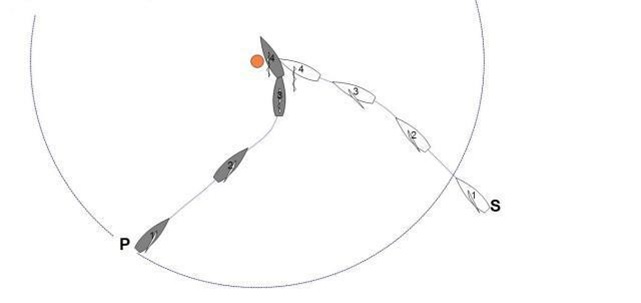


Section B – Boat on boat
RS CALL B3
Rule 13, While Tacking
Rule 14, Avoiding Contact
Rule 16.1, Changing Course
Rule 43, Exoneration
When a right-of-way boat changes course and thereby creates a situation that will
cause a breach of a rule by the other boat, she breaks rule 16.1 if she maintains that
course. However, she may change course again to comply with rule 16.1, in which
case neither boat breaks a rule.
Assumed Facts
Approaching a windward mark to be left to port, S is fetching the mark closehauled
on starboard from outside the zone, more than a boat-length above the
lay line. P, on port, is on a course to keep clear of S.
S enters the zone, bears away towards the mark onto a collision course with P. P
luffs immediately and passes through head to wind but, before she has reached a
starboard close-hauled course, there is contact between S's bow and P's starboard
side. There is no damage.

Question 1
Which rule, if any, has been broken?
Answer 1
S was the right of way boat and, before S changed course, P was keeping clear.
When S changed course, she became required to give room to P to keep clear
including, in this situation, room to comply with her obligations under rules 13 and
31. P manoeuvred promptly to keep clear, but was unable to avoid contact with S.
S broke rule 16.1 and should take a penalty.
In failing to keep clear, P broke rule 13; however, that was as a consequence of S's
breach of rule 16.1. P was sailing within the room to which she was entitled under
rule 16.1 and is exonerated under rule 43.1(b)
As P was not given room to keep clear, it was not reasonably possible for P to
avoid contact. P did not break rule 14. S could have avoided contact and, therefore,
broke rule 14. However, as there was no damage, S is exonerated, under rule
43.1(c) from her breach of rule 14 as she was the right-of-way boat.
Question 2
P avoids contact with S but, in doing so, touches the mark. Which rule, if any, has
been broken?
Answer 2
When S changes course towards the mark, she becomes required under rule 16.1 to
give P room to keep clear including room to comply with her obligations under the
rules of part 2 and rule 31. If P is compelled to touch the mark in order to avoid
contact with S, then S has not given P room to comply with rule 31. S breaks rule
16.1. P breaks rule 31 and is exonerated under rule 43.1(b) because she was sailing
within the room to which she was entitled under rule 16.1.
Question 3
When less than a boat length from P, S luffs and there is no contact. Which rule
if any has been broken?
Answer 3
S, a right of way boat changing course, is required under rule 16.1 to give room to P
to keep clear. By changing course again, S gives P room to keep clear. No rule has
been broken.






